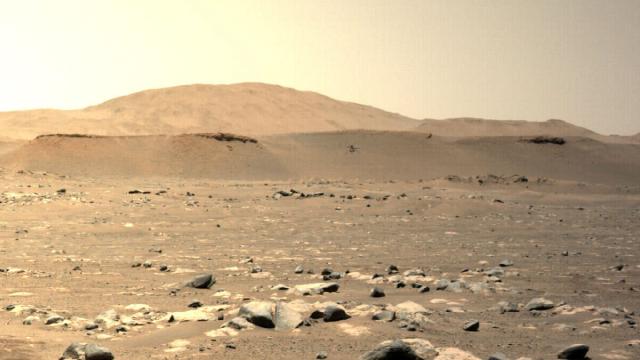On Sunday, Ingenuity demonstrated once again that it was the little Mars helicopter that could. NASA reported that Ingenuity had successfully completed its third test flight earlier in the day, flying further and faster than it ever had in tests conducted on Earth.
Ingenuity carried out its third flight at 3:30 p.m. AEST, although NASA began receiving the data at 12:16 a.m. AEST. The helicopter rose 5 metres, which is the same altitude as its second test flight, and flew 50 metres downrange. Ingenuity’s flight lasted 80 seconds, the space agency said, during which it managed to reach a top speed of 2.01 m per second.
On Friday, Håvard Grip, Ingenuity’s chief pilot at NASA’s Jet Propulsion Laboratory, said in a status update that the helicopter team’s plan since day one has been to prepare, fly, analyse the data, and then “plan for an even bolder test in the next flight.”
When you compare today’s flight to Ingenuity’s second flight on Thursday, you can definitely see Grip wasn’t kidding. Only a few days ago, Ingenuity travelled two metres to the east and back on a 51.9-second flight. Fast forward a few days and Ingenuity’s travelled almost half the length of a football field in 80 seconds.
“Today’s flight was what we planned for, and yet it was nothing short of amazing,” Dave Lavery, the program executive for the Ingenuity Mars helicopter at NASA headquarters, said in a news statement published by the space agency on Sunday. “With this flight, we are demonstrating critical capabilities that will enable the addition of an aerial dimension to future Mars missions.”
The helicopter’s third test flight also tested its ability to process images taken by its black-and-white navigation camera, a device that tracks the planet’s surface features below Ingenuity. Ingenuity’s flight computer “utilises the same resources as the cameras.” This is very important given that the flight computer is what flies the helicopter autonomously after receiving instructions from NASA hours beforehand.
Ingenuity’s camera takes more images the greater the distance, NASA explained. However, if the helicopter flies too fast, its flight algorithm can’t track surface features. The space agency had only tested Ingenuity in small vacuum chambers on Earth, where it could only move about half a metre in any direction. To replicate the Martian atmosphere, which is only 1% as thick as Earth’s, the chambers are filled with wispy air, mainly carbon dioxide.
Given the speed, range, and altitude planned for the third test flight, NASA was unsure whether Ingenuity’s camera would track the ground as designed while it was moving faster.
“This is the first time we’ve seen the algorithm for the camera running over a long distance,” MiMi Sung, Ingenuity’s project manager at NASA’s Jet Propulsion Laboratory, said in the news release. “You can’t do this inside a test chamber.”
Based on the successful flight, it would seem so, but we’ve asked NASA for clarification on whether the camera worked as expected.
Not only that, but the Ingenuity team also pushed the helicopter’s limits by instructing it to take more photos on its own, including with its colour camera. NASA recently released the first aerial colour images taken by Ingenuity on its second flight. You can even see tracks made by the Perseverance rover, which is essentially serving as Ingenuity’s proud and watchful parent as it zooms around the Martian surface.

NASA’s little helicopter is currently carrying out a 30-Martian-day, or 31-Earth-day, technology demonstration that aims to test rotorcraft flight in Mars’ thin atmosphere. It will attempt up to five test flights within that window. The space agency said the Ingenuity team is planning the helicopter’s fourth flight, which will take place in a few days.
